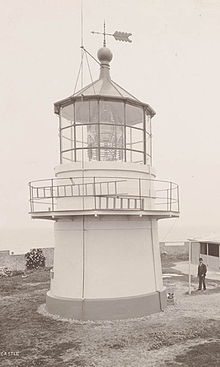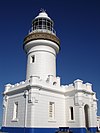Nobbys Head Light
 Nobbys Head Light, 1902 | |
 | |
| Location | Nobbys Head Newcastle, New South Wales |
|---|---|
| Coordinates | 32°55′07″S 151°47′53″E / 32.9186°S 151.798°E |
| Tower | |
| Constructed | 1821 |
| Construction | dressed sandstone |
| Automated | 1935 |
| Height | 32 feet (9.8 m)[2] |
| Shape | cylindrical tower with balcony and lantern |
| Markings | white tower and lantern |
| Operator | Australian Maritime Safety Authority |
| Heritage | listed on the Commonwealth Heritage List |
| Fog signal | Siren(1) 20s |
| Light | |
| First lit | 1858[1] |
| Focal height | 115 feet (35 m)[3] |
| Intensity | 580,000 cd |
| Range | 24 nautical miles (44 km; 28 mi) |
| Characteristic | Fl.(2+1) W. 20s |
Nobbys Head Light is an active lighthouse on Nobbys Head, a headland on the south side of the entrance to Newcastle Harbour, New South Wales, Australia. An image of the lighthouse is included in the Coat of Arms of the City of Newcastle.[8]
The lighthouse is operated by the Newcastle Port Corporation. The headland is managed by the Land Property Management Authority[9] and is open to the public Sundays from 10am to 4pm.
History
The first beacon in the area was an open coal fire set on Signal Head, with a range of 7 kilometres (4.3 mi). This was changed in 1821 to a large metal device burning oil, which was visible for 12 kilometres (7.5 mi), but shortly reverted to coal as the oil system was not reliable.
By 1846 Nobbys Head, originally a small islet more than 60 metres (200 ft) high, was connected to the mainland with a causeway. The island was reduced in height to improve the sailing conditions and to accommodate a lighthouse and signal station, built in 1858. The lighthouse was designed by Alexander Dawson. The original light had an intensity of 20,000 cd and was attended by three lighthouse keepers.
In 1934 the light was electrified and automated.
The current light source is a 120 volt 1,000-watt (1.3 hp), quartz halogen lamp and the power source is mains electricity with a diesel generator as backup. Currently at the site are three one-story keeper's houses, a three-story signal station, and other buildings housing the port watch. The entire station is floodlit at night.
Gallery
-
Nobbys Head, 2009
-
Nobbys Head in 1887
-
View of Nobbys Head from a distance
See also
References and notes
- ^ According to "Lighthouses of Australia". Directory of Lighthouses says 1854.
- ^ According to List of Lights. "Lighthouses of Australia" says 35m.
- ^ According to List of Lights. "Lighthouses of Australia" says 25m.
- ^ List of Lights, Pub. 111: The West Coasts of North and South America (Excluding Continental U.S.A. and Hawaii), Australia, Tasmania, New Zealand, and the Islands of the North and South Pacific Oceans (PDF). List of Lights. United States National Geospatial-Intelligence Agency. 2009. p. 124.
- ^ Rowlett, Russ. "Lighthouses of Australia: Northern New South Wales". The Lighthouse Directory. University of North Carolina at Chapel Hill. Retrieved 2010-08-29.
- ^ "The Nobbys Head Lighthouse at Newcastle". Lighthouses of New South Wales. Lighthouses of Australia Inc.
- ^ Searle, Garry. "Nobby". Lighthouses of New South Wales. SeaSide Lights.
- ^ "Commonwealth heritage places in New South Wales (Nobbys Lighthouse, Newcastle East)". Department of the Environment, Water, Heritage and the Arts. Retrieved 2008-07-21.
- ^ McMahon, Jeannette (23 November 2010). "Opening Nobbys headland to the public". ABC News. Newcastle, Australia. Retrieved 23 March 2013.




